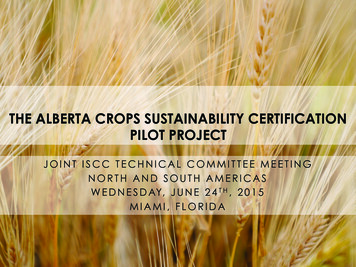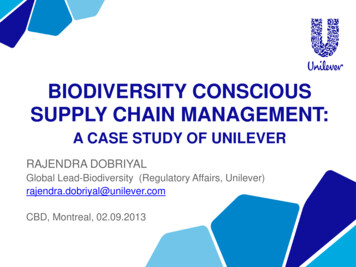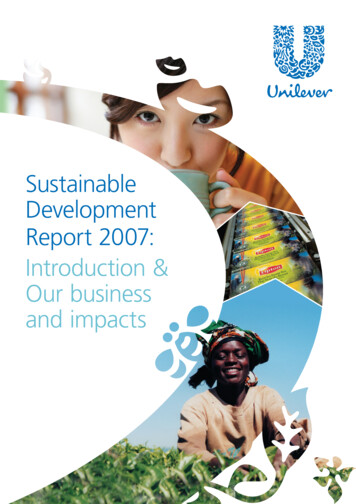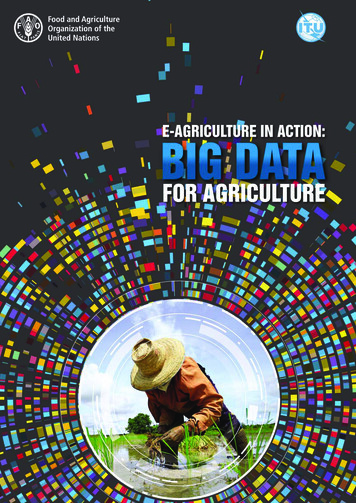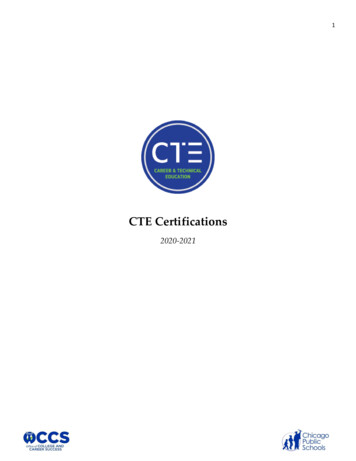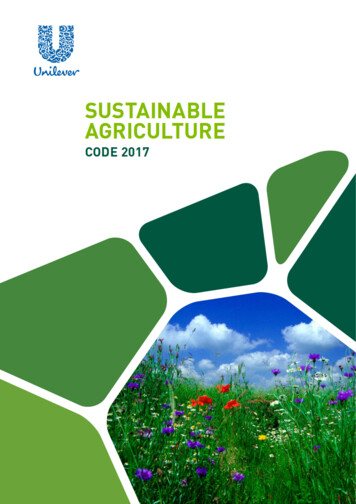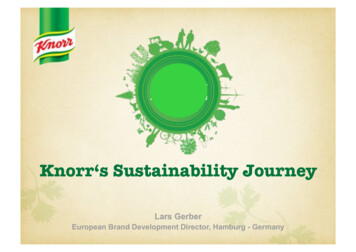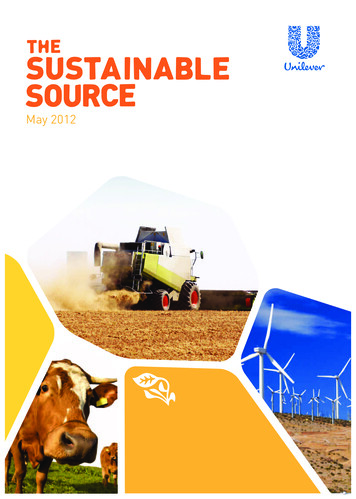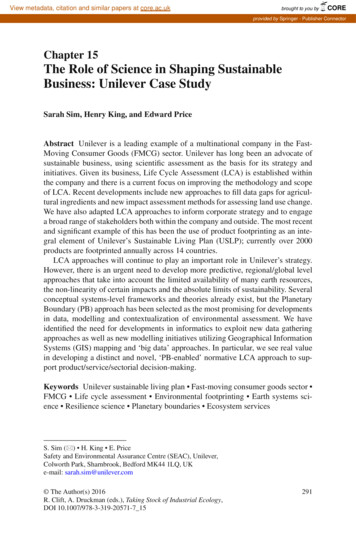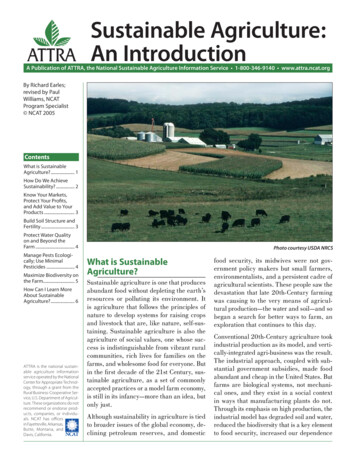
Transcription
Sustainable Agriculture:ATTRA An IntroductionA Publication of ATTRA, the National Sustainable Agriculture Information Service 1-800-346-9140 www.attra.ncat.orgBy Richard Earles;revised by PaulWilliams, NCATProgram Specialist NCAT 2005ContentsWhat is SustainableAgriculture? . 1How Do We AchieveSustainability? . 2Know Your Markets,Protect Your Profits,and Add Value to YourProducts . 3Build Soil Structure andFertility . 3Protect Water Qualityon and Beyond theFarm . 4Manage Pests Ecologically; Use MinimalPesticides . 4Maximize Biodiversity onthe Farm. 5How Can I Learn MoreAbout SustainableAgriculture? . 6ATTRA is the national sustainable agriculture informationservice operated by the NationalCenter for Appropriate Technology, through a grant from theRural Business-Cooperative Service, U.S. Department of Agriculture. These organizations do notrecommend or endorse products, companies, or individuals. NCAT has officesin Fayetteville, Arkansas,Butte, Montana, and Davis, California.Photo courtesy USDA NRCSWhat is SustainableAgriculture?Sustainable agriculture is one that producesabundant food without depleting the earth’sresources or polluting its environment. Itis agriculture that follows the principles ofnature to develop systems for raising cropsand livestock that are, like nature, self-sustaining. Sustainable agriculture is also theagriculture of social values, one whose success is indistinguishable from vibrant ruralcommunities, rich lives for families on thefarms, and wholesome food for everyone. Butin the first decade of the 21st Century, sustainable agriculture, as a set of commonlyaccepted practices or a model farm economy,is still in its infancy—more than an idea, butonly just.Although sustainability in agriculture is tiedto broader issues of the global economy, declining petroleum reserves, and domesticfood security, its midwives were not government policy makers but small farmers,environmentalists, and a persistent cadre ofagricultural scientists. These people saw thedevastation that late 20th-Century farmingwas causing to the very means of agricultural production—the water and soil—and sobegan a search for better ways to farm, anexploration that continues to this day.Conventional 20th-Century agriculture tookindustrial production as its model, and vertically-integrated agri-business was the result.The industrial approach, coupled with substantial government subsidies, made foodabundant and cheap in the United States. Butfarms are biological systems, not mechanical ones, and they exist in a social contextin ways that manufacturing plants do not.Through its emphasis on high production, theindustrial model has degraded soil and water,reduced the biodiversity that is a key elementto food security, increased our dependence
on imported oil, and driven more and moreacres into the hands of fewer and fewer“farmers,” crippling rural communities.Little bylittle—onecrop, onefield, one family ata time—sustainable farming istaking root.In recent decades, sustainable farmers andresearchers around the world have respondedto the extractive industrial model with ecology-based approaches, variously called natural, organic, low-input, alternative, regenerative, holistic, Biodynamic, biointensive, andbiological farming systems. All of them, representing thousands of farms, have contributed to our understanding of what sustainable systems are, and each of them sharesa vision of “farming with nature,” an agroecology that promotes biodiversity, recyclesplant nutrients, protects soil from erosion,conserves and protects water, uses minimum tillage, and integrates crop and livestock enterprises on the farm.Farmers and other agricultural thinkers haveestablished a strong set of guiding principlesfor sustainability, based on stewardship andeconomic justice. Producers and researchersare annually increasing the pace of improvements in agro-ecology systems, making themmore efficient and profitable. More Cooperative Extension offices and colleges of agriculture are endorsing sustainable practices. Andevery year more farmers are seeing the wisdom and rewards—both economic and personal—in these systems. (Organic productsare the fastest growing grocery segment inthe United States.) Little by little—one crop,ATTRAOff the farm, consumers and grassroots activists are working to create local markets andfarm policies that support sustainable practices. They are working to raise consumers’awareness about how their food is grown andprocessed—how plants, animals, the soil, andthe water are treated. And they are workingto forge stronger bonds between producersand consumers that will, in time, cement thefoundations of locally and regionally selfsufficient food systems. In contrast to monocropped industrial megafarms that shipJam processed on-farm is one example of a valueadded product. Photo by Nathalie Dulex.But no matter how elegant the system or howaccomplished the farmer, no agriculture issustainable if it’s not also profitable, able toprovide a healthy family income and a goodquality of life. Sustainable practices lendthemselves to smaller, family-scale farms.These farms, in turn, tend to find their bestniches in local markets, within local food systems, often selling directly to consumers. Asalternatives to industrial agriculture evolve,so must their markets and the farmers whoserve them. Creating and serving new markets remains one of the key challenges forsustainable agriculture.How Do We AchieveSustainability?Page 2one field, one family at a time—sustainablefarming is taking root.throughout the world, the vision of sustainable agriculture’s futurists is small to midsize diversified farms supplying the majorityof their region’s food. (No one in Idaho hasto give up orange juice, and there will stillbe cranberries in California for Thanksgiving.)Listed below are some of the key considerations for making a farm more sustainable,along with relevant ATTRA publications inthose areas. Because each farm is different, there’s no single formula for sustainablesuccess, but these principles and publications are good places to begin learning whatSustainable Agriculture: An Introduction
it will take. And for a more detailed look atsome of these same fundamentals, see theATTRA publication Applying the Principlesof Sustainable Agriculture.Know Your Markets, ProtectYour Profits, and Add Valueto Your Products Diversify enterprises. Market outside the commodity supplychains and corporate vertical integrators. Emphasize direct marketing and premium specialty markets. Consider forming a cooperative with otherfarmers. Add value through on-farm processing.4 Holistic Management4 Evaluating a Rural Enterprise4 Moving Beyond Conventional CashCropping4 Entertainment Farmingand Agri-Tourism4 Agricultural Business PlanningTemplates4 Enterprise Budgets and Production Costsfor Organic Production4 Preparing for an Organic Inspection:Steps and Checklists4 Direct Marketing4 Farmers’ Markets4 CSA (Community Supported Agriculture)4 Bringing Local Food to Local Institutions4 Selling to Restaurants4 Organic Certification and the NationalOrganic Program4 Organic Marketing Resources4 Alternative Meat Marketing4 USDA-RBS Series on Cooperatives4 Keys to Success in Value-addedAgriculture4 Adding Value to Farm Products: AnOverview4 Grain Processing4 Oilseed Processing for Small Producers4 Food Dehydration Options4 Soyfoods: Adding Value to Soybeans4 Sorghum Syrup4 Value-added Dairy OptionsFresh peaches at afarmers market in California. Photo by ErikDungan.Build Soil Structureand Fertility Reduce the use of synthetic fertilizers byincreasing on-farm nutrient cycling. Make fertilization decisions based onsoil tests. Minimize or eliminate tillage. Think of the soil not only as a physicaland chemical substrate but as a livingentity; manage the soil organisms to preserve their healthy diversity. Maintain ground cover year-round byusing cover crops and mulches and byleaving crop residues in the field.4444Sustainable Soil ManagementDrought Resistant SoilNutrient Cycling in PasturesManures for Organic Crop ProductionNo-till soybeans growing through wheat stubble inKansas. Photo courtesy USDA NRCS.www.attra.ncat.orgATTRAPage 3
and sediment movement into lakes andstreams. Manage irrigation to enhance nutrientuptake and decrease nutrient leaching. Produce livestock in pasture-based systems.Streams without conservation buffers run higherrisks of streambankerosion, contaminationwith farm chemicals,and sedimentation, aswell as offer no habitatfor wildlife. Photo byLynn Betts, USDA NRCS.4 Overview of Cover Crops and GreenManures4 Overview of Organic Crop Production4 Farm-scale Composting Resource List4 Conservation Tillage4 Pursuing Conservation Tillage Systemsfor Organic Crop Production4 Assessing the Pasture Soil Resource4 Alternative Soil Testing Laboratories4 Alternative Soil Amendments4 Sources of Organic Fertilizers andAmendmentsProtect Water Quality onand Beyond the Farm Use soil-building practices that increasesoil organic matter and support a biologically active humus complex. Use soil conservation practices that reduce the potential for water runoff anderosion. Plant perennial crops such as forages,trees, and shrubs. Plant catch crops or cover crops to takeup nutrients that may otherwise leachinto the subsoil. Provide buffer areas between fields andwater bodies to protect against nutrient4 Nutrient Cycling in Pastures4 Protecting Water Quality on OrganicFarms4 Protecting Riparian Areas4 Managed Grazing in Riparian Areas4 Conservation Easements4 Montana Irrigator’s Pocket Guide4 Constructed Wetlands4 Conservation Tillage4 Sustainable Soil Management4 Drought Resistant Soil4 Sustainable Pasture Management4 Agroforestry OverviewManage Pests Ecologically;Use Minimal Pesticides Prevent pest problems by buildinghealthy, biologically active soil; by creating habitat for beneficial organisms; andby choosing appropriate plant cultivars. View the farm as a component of an ecosystem, and take actions to restore andenhance pest–predator balances. Understand that the mere presence of a pestdoes not necessarily constitute a problem; base any intervention on monitoringLady beetles look for aphids on a fava bean leaf.Scientists think the beetles might help in controllingRussian wheat aphids that now infest 17 Great Plainsand Western states. Photo by Scott Bauer, USDA ARS.Page 4ATTRASustainable Agriculture: An Introduction
(crop scouting) and economic damagethresholds. Before intervening with a chemical, positively identify the pest species and learnabout its life cycle and ecology. Implement cultural practices that alter thecropping system and surrounding habitat to make life more difficult for the pestand easier for its natural enemies. Use pesticides as the last resort, whenbiological and cultural controls havefailed to keep pest populations below economically damaging levels. If you haveto use chemicals, seek out the least-toxicpesticide that will control the pest.4 Biointensive Integrated PestManagement4 Farmscaping to Enhance BiologicalControl4 Sustainable Management of Soil-bornePlant Diseases4 Integrated Pest Managementfor Greenhouse Crops4 Principles of Sustainable WeedManagement4 Integrated Parasite Management forLivestock4 A Whole Farm Approach to ManagingPests (SAN publication)Maximize Biodiversity onthe Farm Integrate crop and livestock production. Use hedgerows, insectary plants, covercrops, and water reservoirs to attract andsupport populations of beneficial insects,bats, and birds. Abandon monocropping in favor of croprotations, intercropping, and companionplanting. Plant a percentage of your land in treesand other perennial crops in permanentplantings or long-term rotations. Manage pastures to support a diverseselection of forage plants. Plant off-season cover crops.4 Farmscaping to Enhance BiologicalControl4 Intercropping Principles and ProductionPractices4 Companion Planting: Basic Conceptsand Resources4 Converting Cropland to PerennialGrassland4 Sustainable Pasture Management4 Multispecies Grazing4 Agroforestry Overview4 Woodlot EnterprisesAs alternatives toindustrialagriculture evolve,so must theirmarkets and thefarmers who servethem.Ewes and lambs onpasture in Linn County,Oregon. Photo by RonNichols, USDA NRCS.www.attra.ncat.orgATTRAPage 5
How Can I Learn More AboutSustainable Agriculture?There is a wealth of historical, philosophical, scientific,practical, and policy-oriented writing on sustainableagriculture. The following list of books and Web sites isoffered as a starting point.Print Resources:AFSIC Staff and Volunteer (eds.). 1997 and 2001.Sustainable Agriculture in Print: Current Books. Special Reference Briefs Series no. SRB 97-05. Alternative Farming Systems Information Center. NationalAgriculture Library, Beltsville, Maryland.www.nal.usda.gov/afsic/AFSIC pubs/srb97-05.htm andwww.nal.usda.gov/afsic/AFSIC pubs/srb9705u.htmFor printed copies contact:Alternative Farming Systems InformationCenterUSDA, ARS, NAL, AFSIC10301 Baltimore Ave.Beltsville, MD 20705-2351301-504-6422afsic@nal.usda.govBerry, Wendell. 1996. The Unsettling of America:Culture and Agriculture. 3rd edition. University of California Press, Davis. 256 p.Bird, Elizabeth Ann R., Gordon L. Bultena, and JohnC. Gardner (eds.) 1995. Planting the Future:Developing an Agriculture that Sustains Landand Community. Iowa State University Press,Ames, IA. 276 p.Horne, James E. and Maura McDermott. 2001. TheNext Green Revolution: Essential Steps to aHealthy, Sustainable Agriculture. Food Products Press, an imprint of The Haworth Press,Binghamton, NY. 312 p.Jackson, Wes. 1985. New Roots for Agriculture.2nd edition. University of Nebraska Press,Lincoln, NE. 150 p.Sustainable Agriculture Network. 2002. Resourcesfrom the Sustainable Agriculture Network.Sustainable Agriculture Research and Education (SARE) Program. Sustainable Agriculture Publications, 210 UVM, Hills Building,Burlington, VT 05405-0082.www.sare.org/htdocs/pubs/Selected Web Sites:(for more go to www.attra.ncat.org/fundamental.html)Agroecology: principles and strategies for designingsustainable farming systemswww.CNR.Berkeley.EDU/%7Eagroeco3/principles andstrategies.htmlAlternative Farming Systems Information Centerwww.nal.usda.gov/afsicSustainable Agriculture: Definitions and Termswww.nal.usda.gov/afsic/AFSIC pubs/srb9902.htmATTRA—National Sustainable AgricultureInformation Servicewww.attra.ncat.orgCenter for Applied Rural Innovation er for Rural Affairswww.cfra.org/Community Alliance with Family Farmers (California)www.caff.org/A small dairy farm in Maryland. Photo by Scott Bauer, USDA ARS.Page 6ATTRASustainable Agriculture: An Introduction
Future Horizons: Recent Literature in csas/extvol6.htmJohn Ikerd’s Series of Papers on /Jikerd/papers/default.htmLand Stewardship Projectwww.landstewardshipproject.org/Leopold Center for Sustainable Agriculturewww.leopold.iastate.eduMinnesota Institute for Sustainable Agriculturewww.misa.umn.edu/Missouri Alternatives Centerhttp://agebb.missouri.edu/mac/National Campaign for Sustainable le Agriculture Networkwww.sare.orgThe New American Farmer: Profiles of f/naf.pdfSustainable Farming n/Sustainable Communities htmlUniversity of California Sustainable AgricultureResearch and Education rgATTRAPage 7
Sustainable Agriculture: An IntroductionBy Richard Earles; revised by Paul Williams,NCAT Program Specialist NCAT 2005Paul Williams, EditorRobyn Metzger, ProductionThis publication is available on the Web www.attra.ncat.org/attra-pub/PDF/sustagintro.pdfIP 043Slot 121Version 042805Page 8ATTRA
A Publication of ATTRA, the National Sustainable Agriculture Information Service 1-800-346-9140 www.attra.ncat.org ATTRA is the national sustain-able agriculture information service operated by the National Center for Appropriate Technol-ogy, through a grant from the Rural Business-Cooperative Ser-vice, U.S. Department of Agricul-ture.


